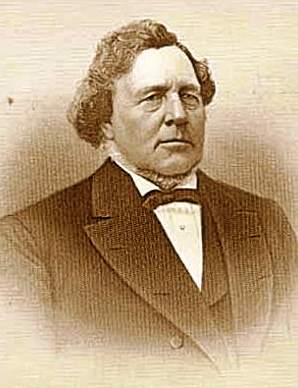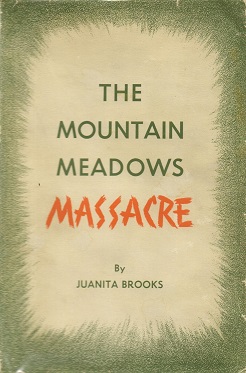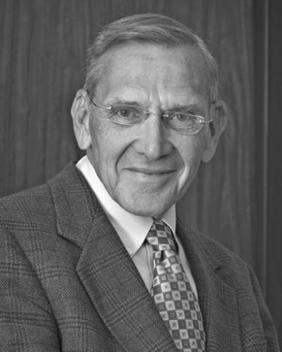
The Mountain Meadows Massacre was a series of attacks during the Utah War that resulted in the mass murder of at least 120 members of the Baker–Fancher immigrant wagon train. The massacre occurred in the southern Utah Territory at Mountain Meadows, and was perpetrated by settlers from the Church of Jesus Christ of Latter-day Saints involved with the Utah Territorial Militia who recruited and were aided by some Southern Paiute Native Americans. The wagon train, made up mostly of families from Arkansas, was bound for California, traveling on the Old Spanish Trail that passed through the Territory.

George Albert Smith was an early leader in the Latter Day Saint movement. He served in the Quorum of the Twelve Apostles and as a member of the First Presidency of the Church of Jesus Christ of Latter-day Saints.

The Baker–Fancher party was a group of American western emigrants from Marion, Crawford, Carroll, and Johnson counties in Arkansas, who departed Carroll County in April 1857 and "were attacked by the Mormons near the rim of the Great Basin, and about fifty miles from Cedar City, in Utah Territory, and that all of the emigrants, with the exception of 17 children, were then and there massacred and murdered" in the Mountain Meadows massacre. Sources estimate that between 120 and 140 men, women and children were killed on September 11, 1857, at Mountain Meadows, a rest stop on the Old Spanish Trail, in the Utah Territory. Some children of up to six years old were taken in by the Mormon families in Southern Utah, presumably because they had been judged to be too young to tell others about the massacre.
The Mormons is a four-hour PBS documentary about the Church of Jesus Christ of Latter-day Saints. The production originally aired in two-hour segments on April 30 and May 1, 2007. It was produced by Helen Whitney, and was the first joint production of Frontline and American Experience.
The history of the Latter Day Saint movement includes numerous instances of violence committed both by and against adherents. Mormons faced significant persecution in the early 19th century, including instances of forced displacement and mob violence in Ohio, Missouri, and Illinois. Notably, the founder of Mormonism, Joseph Smith, was shot and killed alongside his brother, Hyrum Smith, in Carthage, Illinois in 1844, while Smith was in jail awaiting trial on charges of treason and inciting a riot.

Andrew Jenson, born Anders Jensen, was a Danish immigrant to the United States who acted as an Assistant Church Historian of the Church of Jesus Christ of Latter-day Saints for much of the early-20th century. Jenson also served the church as president of the Scandinavian Mission.
Marlin Keith Jensen is an American attorney who has been a general authority of the Church of Jesus Christ of Latter-day Saints since 1989. He served as the official Church Historian and Recorder of the church from 2005 to 2012. He was the 19th man to hold that calling since it was established in 1830. Jensen was made an emeritus general authority in the October 2012 general conference.
Although the Mountain Meadows massacre was covered to some extent in the media during the 1850s, its first period of intense nationwide publicity began around 1872. This was after investigators obtained the confession of Philip Klingensmith, a Mormon bishop at the time of the massacre and a private in the Utah militia. National newspapers also covered the John D. Lee trials closely from 1874 to 1876, and his execution in 1877 was widely publicized. The first detailed work using modern historical methods was published in 1950, and the massacre has been the subject of several historical works since that time.
Mormon public relations have evolved with respect to the Mountain Meadows Massacre since it occurred on September 11, 1857. After a period of official public silence concerning the massacre, and denials of any Mormon involvement, The Church of Jesus Christ of Latter-day Saints took action in 1872 to excommunicate some of the participants for their role in the massacre. Since then, the LDS Church has consistently condemned the massacre, though acknowledging involvement by some local Mormon leaders.
The pursuit of the perpetrators of the Mountain Meadows massacre, which atrocity occurred September 11, 1857, had to await the conclusion of the American Civil War to begin in earnest.
The conspiracy and siege of the Mountain Meadows Massacre was initially planned by its Mormon perpetrators to be a short "Indian" attack, against the Baker–Fancher party. But the planned attack was repulsed and soon turned into a siege, which later culminated in the massacre of the remaining emigrants, on September 11, 1857.

There have been several remembrances of the Mountain Meadows Massacre including commemorative observances, the building of monuments and markers, and the creation of associations and other groups to help promote the massacre's history and ensure protection of the massacre site and grave sites.
The Mountain Meadows massacre was a series of attacks on the Baker–Fancher emigrant wagon train, at Mountain Meadows in southern Utah. The attacks culminated on September 11, 1857, in the mass slaughter of the emigrant party by the Iron County district of the Utah Territorial Militia and some local Indians.

The Mountain Meadows Massacre (1950) by Juanita Brooks was the first definitive study of the Mountain Meadows Massacre.

Massacre at Mountain Meadows is a book by Latter-day Saint historian Richard E. Turley, Jr. and two Brigham Young University professors of history, Ronald W. Walker and Glen M. Leonard. Leonard was also the director of the Museum of Church History and Art in Salt Lake City, Utah. The book concerns the 1857 Mountain Meadows Massacre in southern Utah, and is the latest study of the subject.
Glen Milton Leonard is an American historian specializing in Mormon history.
Richard Eyring "Rick" Turley Jr. is an American historian and genealogist. He previously served as both an Assistant Church Historian of the Church of Jesus Christ of Latter-day Saints and as managing director of the church's public affairs department.
In 1857, at the time of the Mountain Meadows Massacre, Brigham Young, was serving as President of the Church of Jesus Christ of Latter-day Saints and as Governor of Utah Territory. He was replaced as governor the following year by Alfred Cumming. Evidence as to whether or not Young ordered the attack on the migrant column is conflicted. Historians still debate the autonomy and precise roles of local Cedar City LDS Church officials in ordering the massacre and Young's concealing of evidence in its aftermath. Young's use of inflammatory and violent language in response to a federal expedition to the territory added to the tense atmosphere at the time of the attack. After the massacre, Young stated in public forums that God had taken vengeance on the Baker–Fancher party. It is unclear whether Young held this view because of a possible belief that this specific group posed a threat to colonists or that they were responsible for past crimes against Mormons. According to historian William P. MacKinnon, "After the war, Buchanan implied that face-to-face communications with Brigham Young might have averted the Utah War, and Young argued that a north–south telegraph line in Utah could have prevented the Mountain Meadows Massacre."

Ronald Warren Walker was an American historian of the Latter Day Saint movement and a professor at Brigham Young University (BYU) and president of the Mormon History Association. His work, acclaimed by the Mormon History Association, dealt with the Godbeites, the Utah War, and the Mountain Meadows Massacre, among other topics.
Mormon studies is the interdisciplinary academic study of the beliefs, practices, history and culture of individuals and denominations belonging to the Latter Day Saint movement, a religious movement associated with the Book of Mormon, though not all churches and members of the Latter Day Saint movement identify with the terms Mormon or Mormonism. Denominations of the Latter Day Saint movement include the Church of Jesus Christ of Latter-day Saints, by far the largest, as well as the Community of Christ (CoC) and other smaller groups, include some categorized under the umbrella term Mormon fundamentalism.







